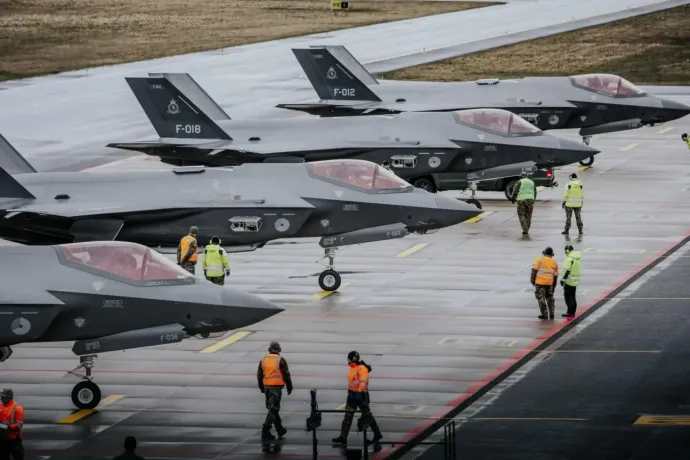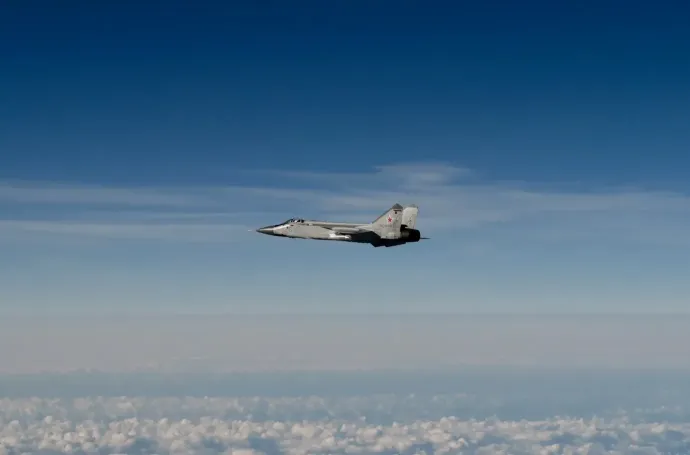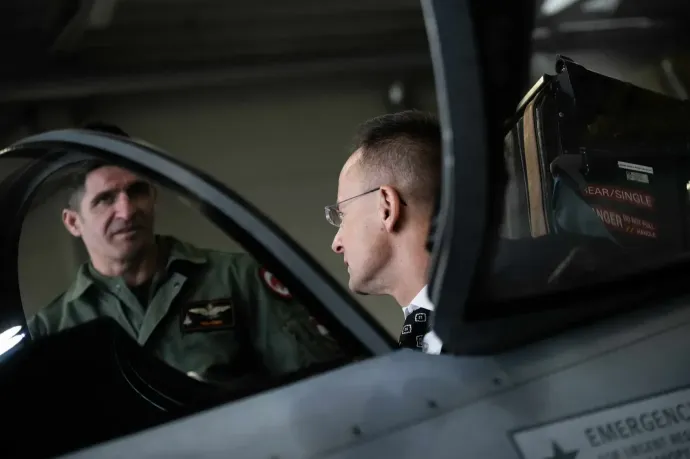Szijjártó took a jab at NATO weeks after alliance demonstrated superiority over Russian air force

"The Baltic air defense mission is currently NATO's most dangerous mission, because this is where the risk of direct confrontation between NATO and the Russian army arises on a daily basis. It is extremely fortunate that Hungarian soldiers are carrying out this mission, because this gives us the best chance of avoiding an escalation of the war and the outbreak of World War III, as Hungarian soldiers are defending the sovereignty of our allies while also safeguarding the opportunity for peace," wrote Péter Szijjártó on November 10 during his visit to Lithuania.
When the Hungarian Minister of Foreign Affairs and Trade wrote this, it had been more than 50 days since Russian aircraft dared enter Estonian, Latvian, or Lithuanian airspace.
This was because on September 19, NATO responded to Russian fighter jets violating its airspace with tactics that have since then discouraged them from entering the airspace of the three NATO member states again, even though this had previously been their regular terrain for testing the military alliance's response.
There are several controversial points in Szijjártó's statement:
- He praised the Hungarian Air Force for its participation in the defense of Baltic airspace, while at the same time implicitly portraying his own allies as warmongers risking a third world war – when in fact it was Italian and Swedish aircraft and the Joint Air Operations Center in Uden, Germany, that had taken decisive action against Russian airspace violations.
- By then, it had been almost two months since "the risk of direct confrontation between NATO and the Russian military" had been a daily occurrence.
- Furthermore, the fact that this is no longer the case is not due to the "great fortune" that "Hungarian soldiers are carrying out this mission," but to the harmonisation of NATO's overall capabilities – in which the Hungarian Air Force undoubtedly plays a part.
- Hungarian fighter jets serving in NATO's Baltic airspace defense operate under NATO command, and their tasks are not determined by the Hungarian government.
Either Péter Szijjártó was unaware of how seriously NATO's procedures for protecting the Baltic states' airspace had changed in response to the previously regular violations of the Russian Air Force, or he deliberately chose not to mention the operation which demonstrated the significant technical superiority of NATO's air force over Russia's.
Violating Baltic airspace was a routine game of Russia
Russia has been known to regularly violate the airspace of the Baltic states. This has happened four times this year alone, more than forty times since 2014, and another twenty times in the past ten years – since Estonia joined NATO.
This provocation is routine, of course, and serves more than just a pointless show of force: it is intended to map out how to prepare a possible air attack, which will hopefully never happen. They assess NATO's response, "where their planes take off from, what radar systems they activate in such a case, what frequency the radar operates on, who they communicate with, and what tactics they use overall," Márk Takács said, explaining the rational background behind such airspace violations. The military expert, who is a former officer in the Hungarian Armed Forces, confirmed what The Military Analyst wrote this week and what was also cited by an unofficial website, NAFO Hungary, which the Hungarian pro-government press describes as a pro-war internet group.
This time, the reception did not follow the usual scenario.
In the event of an airspace violation, aircraft assigned to defense usually approach the enemy aircraft—typically a Russian MiG-31 fighter jet—and the pilots even take photos and wave to each other, escort the aircraft out, and that's the end of the 1-2 minute affair.
However, the Russians have been accused of "escalating tensions and provoking NATO” with an increasing frequency . They have carried out more and more aggressive airspace violations, or have at least approached the airspace in this way," said Takács, who believes that this time it was NATO, or more precisely the officer in charge of airspace protection at the center responsible for NATO operations in the country concerned, who "authorized a complex interception. This is a so-called show of force, a standard military task, the essence of which is to clearly demonstrate perceived or actual superiority in a given area, which clearly had an effect" Takács said.
Just over a week after Russian drones entered Polish airspace, three Russian MiG-31 aircraft flew into Estonian airspace – for the fourth time since May. There is psychological significance to these frequent incursions, as they convey the message that this could happen at any time, that it is not worth mobilizing significant resources to counter them, and that it should be considered normal for the Russian Air Force to be able to do this. The MiG-31s are perfect for this task. They are extremely fast, with a top speed of Mach 2.8, or 2.8 times the speed of sound, roughly 3,400 km/h, a range of 3,000 kilometers, and the ability to climb to an altitude of up to 25,000 meters. In reality, however, these interceptor fighter jets, which were put into service in 1982, are really only suitable for operations typical of the Cold War era.
Russian fighter jets largely rely on ground control, which is characteristic of their procedures. One reason for this is the strict Russian command-oriented leadership culture, and another is the lower technological sophistication of Russian fighter jets. Although the MiG-31's forward-looking radar is powerful, it does not see very well downward.
Since NATO's satellite system and its airborne early warning and control (AWACS) aircraft had already detected the Russian jets as they were approaching Estonian airspace from international waters in the Gulf of Finland, the Joint Air Operations Center ordered two Italian F-35s to take off from the Ämari Air Base in Estonia. These aircraft are much more modern, they were put into service in 2006, with upgraded versions in use since 2016. Their most important strength is not their high speed, but the fact that thanks to their advanced on-board IT systems – as part of an information network – they provide their pilots with a much better situational awareness. They simply have a better and more accurate understanding of the situation.
After taking off, this time with their radars turned off, they were invisible to the Russian jets, while they themselves knew exactly where the MiG-31s were via NATO's Link-16 data link. Compared to previous decades, the situation is much more complicated for the Russians now that Finland and Sweden have joined NATO – which the Kremlin was essentially the catalyst for, by launching the war against Ukraine – so the airspace violation was also monitored by the Swedish Gripen aircraft equipped with Meteor missiles, getting all the data from NATO's Joint Air Operations Center in Uden, Germany, and its AWACS. All this without the Russian aircraft being aware of any of this.

They proceeded according to their routine airspace violation protocol, monitoring NATO's response time and looking for gaps in the radar coverage.
Meanwhile, the F-35s monitored the Russians using their own radars in passive mode, transmitting data to NATO and the Gripens. They were recording everything the Russians were doing, which would later provide NATO with useful information about the Russian Air Force's expected moves.
One of the strengths of the Gripens is radio-electronic warfare: they jam the enemy's radar and communications and project false targets in front of enemy aircraft. Thus, the Zaszlon-M radar in the MiG-31 begins to flash a multitude of incomprehensible signals across the display, which the pilot can no longer use to orient himself.
So instead of the usual fly-by, the Russians were not greeted by waving NATO aircraft politely escorting them out, but rather by a suspiciously long silence – initially. Then their communication with ground control was interrupted, and false data appeared on their instrument panels.
They were essentially flying blind, with not a single NATO aircraft in sight. It was at this point that the Gripen commander contacted the Russian aircraft on the international emergency frequency, informing the pilots: "You are under our control. Leave towards Russian airspace immediately." The whole operation lasted 12 minutes, after which the three Russian aircraft, realizing they had been checkmated, hastily departed. Until the last moment, they had no idea that they had been intercepted by NATO aircraft.
It was obvious to the Russian command that there would be no escape, as they could not even see the enemy aircraft on radar, let alone with the naked eye," the Military Analyst wrote.
If this had been a combat situation, these aircraft would have been destroyed without even being aware of where the hit came from. The fact that NATO's technical superiority was so convincing is evidenced by the fact that Russian aircraft have not attempted a similar airspace violation since. Through this operation, the Russians have come to realize that their air force is actually decades behind in terms of aircraft and that they are at a significant disadvantage compared to NATO in terms of integrated control.
"The Russian Air Force is decades behind NATO in terms of classic air power capabilities. Nowadays, it is no longer the capabilities of the pilot and the aircraft alone that determine the outcome," said Takács.
"We are talking about systems where combat takes place beyond visual range, at a distance of 30-40 kilometers from each other. Here, it is the cooperation between systems and the quality of information management that counts." The Russians currently do not have the complex command capabilities and technical background that NATO possesses. Their air force is currently built on missiles, such as the Kinzhal, and glide bombs, but these are more effective against Ukraine. If the attacked country had NATO-level air defense, these would not be effective offensive weapons either.
NATO has never before taken similar action against Russia. For this to happen, i.e. for the military alliance to highlight Russia's decades-long technological disadvantage, a political decision had to be made.
Hungarian piggybacking on the elephant that is NATO
Szijjártó's statement was therefore both belated and not particularly friendly towards our allies, suggesting that the Hungarian air force is a greater guarantee of preventing a third world war in the region than the others. Additionally, this is far-removed from reality, since the operation did not only rely on aircraft in the air, but also required an entire system with capabilities that the Hungarian Air Force would not possess if it were not a member of NATO.
Furthermore, according to reports, the four fighter jets of the Hungarian Air Force, which are serving in the region along with the Italians and the Spanish until December, did not participate in this operation, and neither did the Spanish.

"In any case, it is not Hungarian soldiers or the Hungarian government that decides what the specific task is in a mission. There is a military hierarchy, and the task is carried out by the Joint Air Operations Center, which works under NATO command, including the aircraft involved," Takács said, noting that this is true for all countries, so he was not specifically commenting on Szijjártó's post.
At the political level, the governments of the member states have instruments at their disposal in the North Atlantic Council, the political decision-making body that decides on the framework for each mission. "The political framework is determined by the governments, the task is carried out by the military, but at this level, no single country has any political say in how this is done in practice."
Another reason why Szijjártó's post is objectionable is that, while he – in line with the Hungarian government's narrative – characterises NATO member states as representing a risk of an escalation of the war, saying that it is really the Hungarian side that is the pro-peace, what NATO did in September was to reduce tensions and deter the Russian side from further provocations by demonstrating its technical superiority without firing a single shot.
In practice, the Hungarian government seems to agree with this, as after the airspace violation on September 19, Estonia called for a consultation, invoking Article 4 of the NATO Charter, and NATO issued a statement condemning not only Russia's incursion into Estonian airspace, but also Russia's aggression against Ukraine.
For more quick, accurate and impartial news from and about Hungary, subscribe to the Telex English newsletter!